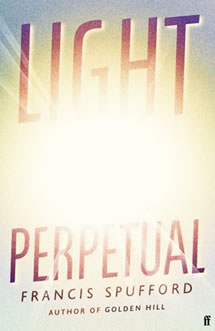Reviewed by Robert Goodman.
By Francis Spufford, Allen and Unwin, $29.99.
 Francis Spufford’s latest novel Light Perpetual is a literary memorial to those who died in the German bombing of London in World War II. It takes as its premise the bombing of a Woolworths by a V2 in 1944 which killed hundreds, including children. Spufford then breaks off into an alternative history in which that bomb, for whatever reason, did not land, and then follows the lives of five of the five-year-old survivors over the course of the next sixty five years. What results, while interesting, is ultimately puzzling and makes little use of that premise except as a tragic underlining of all five stories.
Francis Spufford’s latest novel Light Perpetual is a literary memorial to those who died in the German bombing of London in World War II. It takes as its premise the bombing of a Woolworths by a V2 in 1944 which killed hundreds, including children. Spufford then breaks off into an alternative history in which that bomb, for whatever reason, did not land, and then follows the lives of five of the five-year-old survivors over the course of the next sixty five years. What results, while interesting, is ultimately puzzling and makes little use of that premise except as a tragic underlining of all five stories.
After the opening, Spufford moves to 1949, when the children are nine years-old. The following sections catch up again with each of the five at fifteen year intervals – so when they are 24, 39, 54 and 69. This tends to give the feel of the literary equivalent of the Seven-Up movie series. The book is a series of vignettes in which readers drop into these lives and see where they have gone and what has happened in the meantime. And while this is an alternate history for these characters, who should otherwise not have lived, Spufford has not created an alternate history of the world. So in the background of these stories is the history of England, and particularly of London, and probably more particularly of South London, in the second half of the twentieth century – the music, the politics, the social movements – with each character giving a different angle into the culture.
There is plenty to enjoy in Spufford’s writing – individual passages that give real insight into his characters and the world around them. Literary resonances, particularly those related to teaching and music (and the teaching and sharing of music). Some religious overtones, including a bible thumping speech towards the end.
By taking the approach that he does it is hard to form any real connection with any of the characters. With the exception of Jo and Val, who are sisters, and a couple of very brief encounters, the five all live their own separate lives. So that this becomes five separate stories of five different individuals over the course of sixty five years. There never feels like enough to get your teeth into. The character Ben has no sooner dropped to the depths of his schizophrenia than it is fifteen years later and he is managing his mental health with new drugs. Jo struggles with the question of whether to stay in Los Angeles and follow a music career when suddenly it is fifteen years later and she is a school teacher back in the UK. While this tends to show how random life can be, and there are some callbacks to earlier incidents in later sections, it gives little narrative spine to hold on to.
But the ultimate question is why use the premise at all? Given the action centres around five fictional characters living in a fictional part of South London, the fact that the premise is that had they been real people they would not otherwise have survived death in a real life bombing does not give the rest of their stories any additional resonance. The best that can be said of this premise is that it adds a layer of tragedy beneath a series of stories of fairly ‘ordinary lives’ and provides a commentary on the randomness of existence. It serves to memorialise those children killed by providing them with a possible, fictional existence, even if for most of them it is not always an easy one.
This and over 600 more reviews can be found on Pile by The Bed.











